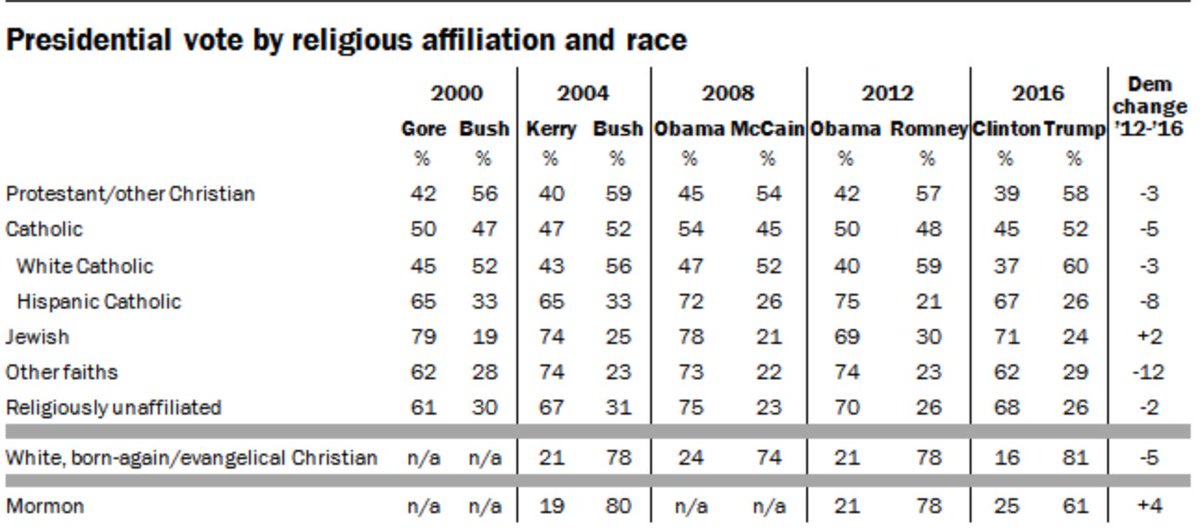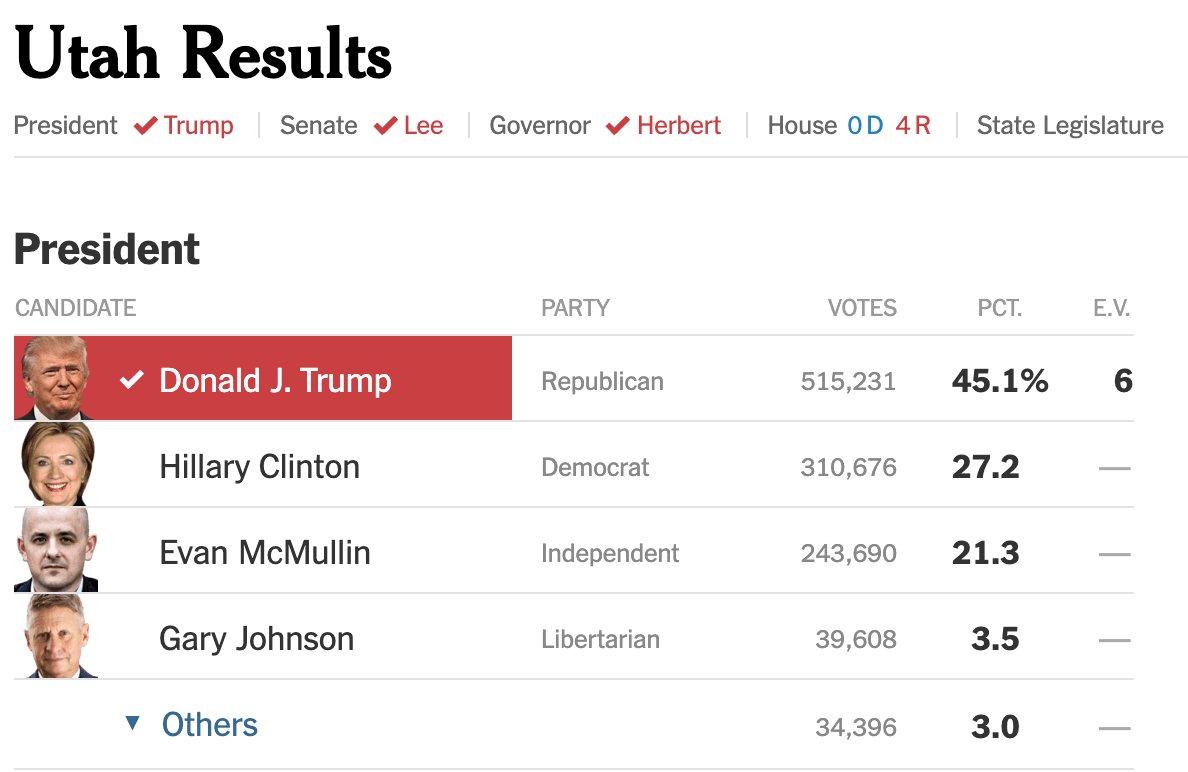It& #39;s Sunday night, the election is (mostly) over, so how about we reflect on what 2020 says about the Mormon vote?
A #MormonAmerica thread. /1
A #MormonAmerica thread. /1
First, for some background: here is what I wrote about the Mormon vote in 2016, which could have been a turning point, but ended up not being one at all. /2 https://twitter.com/BenjaminEPark/status/1298061822571012101">https://twitter.com/BenjaminE...
Despite the unique threat of Trump, especially with the Access Hollywood tape, Mormons did not shift to Democrats for at least 3 reasons: historic connection to GOP, lack of prominent models for faithful democratic vote, and Evan McMullin& #39;s presence. /3 https://professorpark.wordpress.com/2016/11/04/utah-republicans-come-home-to-trump-implications-for-the-mormon-vote/">https://professorpark.wordpress.com/2016/11/0...
So what happened in 2020? Well, it& #39;s probably too early to make definitive statements, but we can observe some preliminary points. For starters, let& #39;s compare 2016 Pew (left) and 2020 VoteCast (right) data. /4
Of course, none of this polling is perfect, as Mormons often comprise a small sample of these much larger surveys. But it does provide a useful trend: a *slightly* higher number of Mormons vote Democrat every 4 years or so, but not much. /5 https://www.pewresearch.org/fact-tank/2016/11/09/how-the-faithful-voted-a-preliminary-2016-analysis/">https://www.pewresearch.org/fact-tank...
There was a dip for Trump in 2016, but that is largely due to Latter-day Saints voting for McMullin, who provided a safe, conservative, and (ahem) Mormon option. You& #39;ll note that LDS support for Trump jumped close to, though not exact, 2012 GOP levels. /6 https://www.npr.org/2020/11/03/929478378/understanding-the-2020-electorate-ap-votecast-survey">https://www.npr.org/2020/11/0...
Another way to look at this is through Utah voting results. Again, far from synonymous with Mormons--LDS comprise decreasing majority in the state--but helpful for overall trends. Here& #39;s 2016 (left) vs. 2020 (right) results. /7
As @janariess notes, Biden& #39;s 38% is 10 points up from Clinton, and is highest Dem vote in a half-century. But note that Biden & Trump basically split the number who voted for McMullin in 2016, so Trump& #39;s support jumped, too. /8 https://religionnews.com/2020/11/05/joe-biden-has-best-showing-of-any-democrat-in-utah-since-1964/">https://religionnews.com/2020/11/0...
However, though Utah& #39;s support for Democratic candidates has risen, national surveys of Mormons have stayed (mostly) the same, so this year-to-year shift might be more a reflection of 1) decreasing LDS share of vote & 2) growing number of liberals not identifying w/the faith. /9
It could be possible that, as a growing number of young progressives leave the LDS religion, the remaining community continues in a more conservative direction. We& #39;ll see. /10
(Also, @janariess has a fabulous essay on this topic in the next issue of #MormonStudiesReview.)
(Also, @janariess has a fabulous essay on this topic in the next issue of #MormonStudiesReview.)
But this is far from the whole story. More than Utah, which was alway staying red, most smart observers turned their attention to Arizona, where it was posited that moderate Mormons (especially LDS women) might play a key role in the state& #39;s swing. /11 https://www.nytimes.com/2020/10/18/us/politics/arizona-mormons-trump-biden.html">https://www.nytimes.com/2020/10/1...
Perhaps most important to this story is @JeffFlake, who served as the very type of model for a faithful Democratic vote that was missing in 2016. Here was his endorsement of Biden, which checked all the boxes for faith and decency. /12 https://twitter.com/JeffFlake/status/1297958223769559040">https://twitter.com/JeffFlake...
But there was also a lot of grassroots organizing among groups like @LDS4BidenHarris and Mormon Women for Ethical Government. This is the type of coalition that will potentially make lasting change. /13 https://www.sltrib.com/news/politics/2020/10/08/latter-day-saints-biden/">https://www.sltrib.com/news/poli...
They posed enough of a problem in Arizona that a competing organization, Latter-day Saints for Trump, had to expend a lot of energy and hold a series of events there. It& #39;s remarkable they couldn& #39;t take LDS vote for granted. /14 https://www.azcentral.com/story/news/politics/elections/2020/10/15/donald-trump-jr-rallies-voters-latter-day-saints-trump-event-mesa-arizona/3669336001/">https://www.azcentral.com/story/new...
Did Mormons end up playing a role in Arizona& #39;s shift blue? Difficult to say. Y2 Analytics polls show LDS Dem votes doubled in AZ, but that was only up from a paltry 9% in 2016. Navajo and Hispanic organizing probably meant more, but every vote counts. /15 https://www.deseret.com/faith/2020/11/5/21550223/latter-day-saint-maricopa-county-arizona-mormon-presidential-election-votes-trump-utah">https://www.deseret.com/faith/202...
But what about longterm trends, beyond 2020 circumstances?
I see a few instances of Mormons following broader, notable trajectories regarding 1) external indentifiers and 2) generational divides. /16
I see a few instances of Mormons following broader, notable trajectories regarding 1) external indentifiers and 2) generational divides. /16
As Mormons become more entrenched in broader American cultural contexts, both inside and outside of Utah, they will reflect cultural trends more dominant than denominational traditions. That is, identifiers like race, class, and gender will take precedence over religion. /17
Note how pollsters are (finally) separating white born-again/evangelicals into their own category. I imagine that we& #39;ll eventually see a similar divide in the Mormon tradition, though to a smaller degree, separated among racial (white) & cultural (fundamentalist) marks. /18
Take, for example, how education is becoming a big divider within LDS communities, as seen in BYU community. 9 Provo precincts surrounding the school turned blue, surrounded by some of the reddest counties in the nation. All Mormon, different worlds. /19 https://twitter.com/JakeRugh/status/1324042104067284993">https://twitter.com/JakeRugh/...
And finally, Mormon youth, just like religious youth across America, are becoming more liberal. @JakeRugh has traced this out in BYU students, as has @janariess in her fabulous book on Mormon millennials. /20 https://medium.com/@jakerugh/i-asked-400-former-byu-students-who-they-plan-to-vote-for-in-2020-their-answers-will-surprise-you-ba6ec8a30c6d">https://medium.com/@jakerugh...
And here is the results for @janariess& #39;s surveys, culminating in her wonderful THE NEXT MORMONS book. /21 https://thenextmormons.org/survey-results/ ">https://thenextmormons.org/survey-re...
The big question, though, as I outlined above, is whether these progressive Mormons remain inside the faith, as we are witnessing many of them leave over political and cultural issues, especially LGBT topics. Will they shape the church in the future, or leave it behind? /22
So there you have it, my preliminary thoughts on the state of the Mormon vote in America at 2020: still very conservative, but flexible in particular circumstances; experiencing a generational shift, but unclear the lasting implications. We& #39;ll see where we are in 2024. /fin

 Read on Twitter
Read on Twitter






